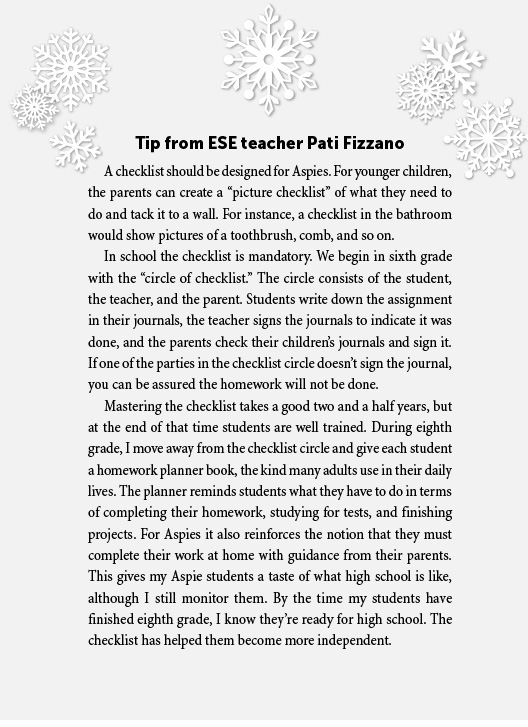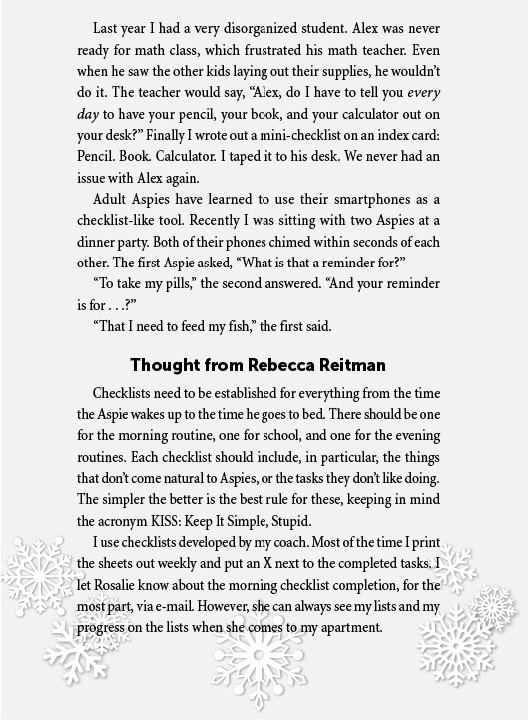
19 Checklists: The Indispensable Tool
Good checklists are easy to use
even in the most difficult situations.
They do not try to spell out everything.
They provide reminders of only the
most important steps—the ones that even
the highly skilled professional using
them could miss. Good checklists
are, above all, practical.
—Atul Gawande, The Checklist Manifesto:
How to Get Things Right
Helpful Hint: All of us use checklists now and then, but for Aspies, checklists are indispensable. A simple checklist will help them make sure they did all their tasks when they were supposed to. It can remind them what to eat for breakfast or what to wear. It can relieve much of their anxiety about appointments, will help them be on time, and will even help them become more independent. Once they see that a task is checked off, they can relax knowing it’s been accomplished. They don’t have to stress over whether they remembered to do it as they’re rushing out the door. A good checklist can at times be a partial substitute for an Aspie’s lack of executive function.
Principle: The mundane details of daily living that neurotypicals sleepwalk through are daunting to the poor Aspie: getting up on time, remembering to brush his teeth, take a shower, put on clean underwear, get dressed, eat a good breakfast, and bring everything he’ll need for the day ahead. Getting out the door. In addition to lacking the overall executive functioning22 to perform this list of daily chores, moving from each one requires a transition, and as we’ve already seen, transitions can overwhelm Aspies. Now stir in their anxiety, the pressure to be on time, and the constant interruptions that besiege all of us, and you have a recipe for failure. The Aspie might just decide that rather than walk out the door, it’s easier to go back to the undemanding environment of his bedroom.
22 Executive function (also known as cognitive control and supervisory attentional system) is an umbrella term for the management (regulation, control) of cognitive processes, including working memory, reasoning, task flexibility, and problem solving, as well as planning and execution.
What can give them the confidence of knowing that as they walk out the door, they have not forgotten something yet again? What can help them see not the formidability of one big, overwhelming task but a series of smaller accomplishable tasks? Answer: A checklist, the easy-to-create tool that will reduce Aspies’ anxiety and make their day run smoothly. All they need is a piece of paper and a pen. This simple document will constantly change, but at any one point in time it is fixed, specific, and in order, just the way an Aspie likes. The checklist makes the Aspie’s daily activities more predictable and therefore less stressful and helps the Aspie navigate each day’s landscape more efficiently.
Like any change to Aspies’ environments, don’t expect your Aspie to welcome the idea of the checklist at first. Introduce it to his routine gradually. Once the checklist becomes part of his beloved routine, he’ll come to embrace it. It will be like a dependable guide dog that helps him keep up with the transitions of each day and prevents him from feeling overwhelmed or panicked. Just remember, don’t try to establish the entire checklist at once. Baby steps! Chunking, in effect.
When Aspies look at the checklist and see that every item has been checked off, they’ll gain confidence from that reassuring visual. And out the door they’ll go with a “Whew!” and a smile, instead of worrying, “What did I forget this time?”
Even after the Aspie embraces this Aspertool, someone—a parent, a teacher, a caring third party, or even one of the Aspie’s friends—will still have to check up on him regularly to make sure he’s following the checklist. That someone is part of the circle of those entrusted to ensure that the checklist is being completed. All the members of the circle must do their part.
As Aspies learn how to add items to the checklist, their independence will be maximized. That’s the goal. Some (but not most) Aspies evolve so that they can check on themselves and no longer need a third party to do that.

Imagine you’re an Aspie. You know you have to be at the event taking place across the street in ten minutes. Just as you get ready to leave your apartment, a barrage of questions comes rushing to your brain. “Do I have everything? Am I dressed properly? Do I have my medications with me? Do I have my directions to the meeting room? What am I forgetting?” A quick glance at the checklist you prepared the night before reminds you of everything you need to do and bring. You breathe a sigh of relief, and out the door you go.
We all need tools to help us remember everything we need to. (I’ve never figured out exactly what my “label” is, but I feel that same type of “Do I have everything?” anxiety each time I go through airport security. And there have been times when I started walking to the gate from the security area, only to realize I’d forgotten my laptop computer!) But for the Aspie that need is magnified. As with all Aspertools, the key is getting Aspies to accept the methods that will maximize their independence long after we are gone. A checklist is a part of a system of dependable things that will reduce the need for helicopter parents so that the Aspie can have a fulfilling, safe, productive life and an independent existence. This is what everyone in the Aspie circle is after. However, anyone in the circle—teacher, coach, student, parent, friend—can break it by neglecting his duty, to the detriment of the student.
In many schools the Aspies use a checklist-like tool, a simple homework planner to write down their daily assignments. The teacher checks them every so often to make sure the Aspies are writing down the correct assignments. If they are, they get a reward; if not, they get a fine or another consequence. The student then takes the planner home and a parent checks the work and signs off on it. This is how the circle works with the school planner.
For example, an eighth-grade Aspie named Daniel created his checklist of assignments with the help of his ESE teacher and left school confident that he was all set to take care of his homework. At home, however, he became confused with his assignments, and his mother neglected to go over his work and check off the items on his planner. Daniel came to school the next day without having completed his tasks and therefore received a fine—a deduction of the points he’d accrued for all his positive activities, points he could turn in for prizes. This negative cycle repeated itself for a week. The fines piled up. The teacher called Daniel’s mom to discuss it. It turns out that the harried mother had been neglecting her role in the circle.
This is not unusual. Parents are often the ones who break the circle. Many parents say to themselves, “Oh, I’ll sign the checklist later . . .” but forget to do it. Unfortunately, when that happens, the student suffers the consequences. Then the teacher feels bad because he has to “fine” the Aspie student.
Ultimately, the checklist should be the Aspies’ responsibility, an independent goal for them to accomplish without others checking on them. But when I asked Daniel’s ESE teacher, who specializes in Asperger’s, how many of her eighth-graders were creating their checklists independently, her answer was only two of the eleven students.
ACTION PLAN: Make sure your Aspie gets the help he needs to create a checklist and keep it current. Individuals in the “circle” should know their role and their schedule for checking on the Aspie. Checklists will keep the individual Aspie from being overwhelmed by the activities of daily living. The checklist—finite, tangible, specific—is easy to implement. Best of all, it works. All in all, it’s one of the most effective Aspertools.


